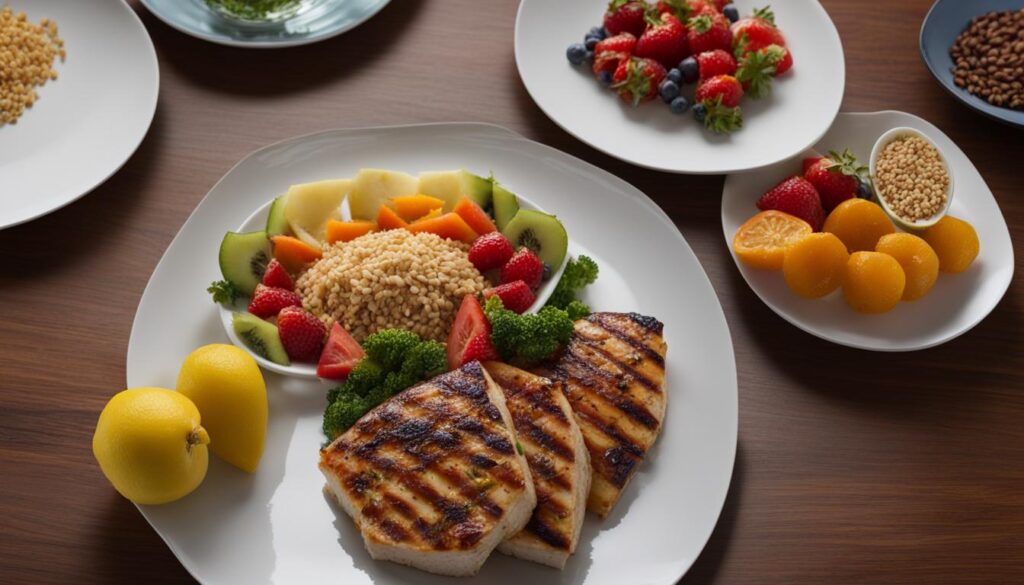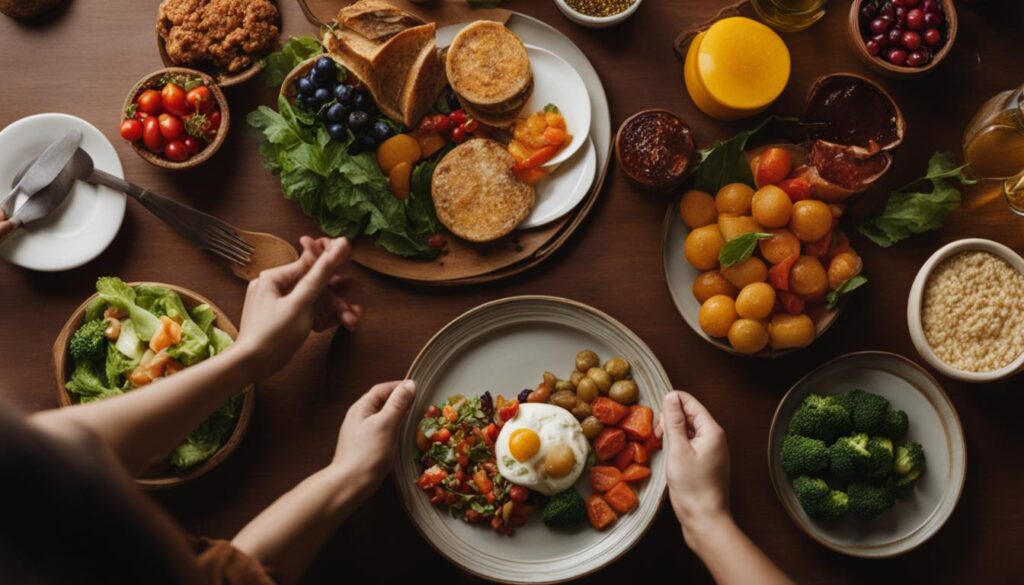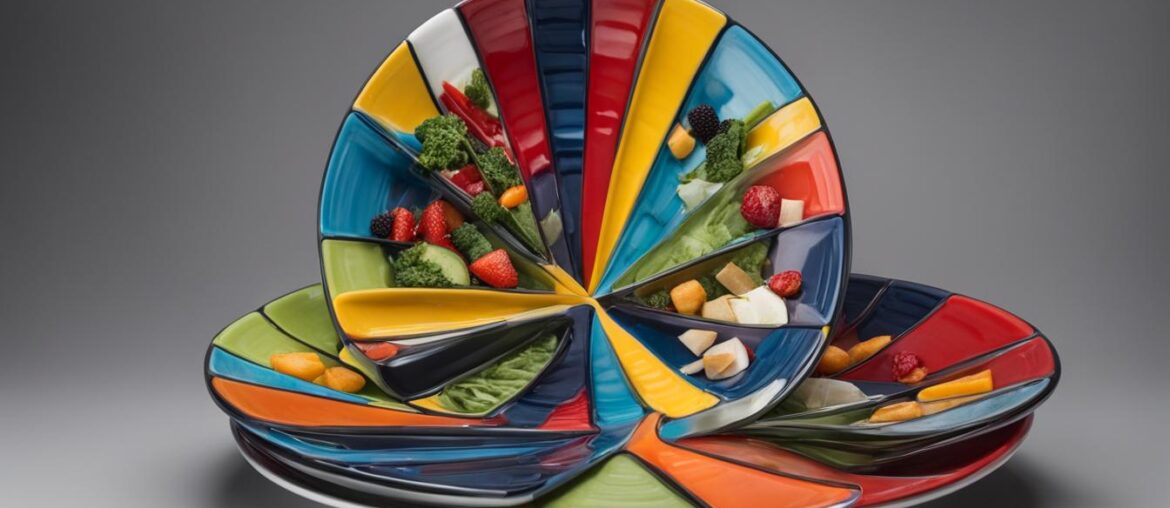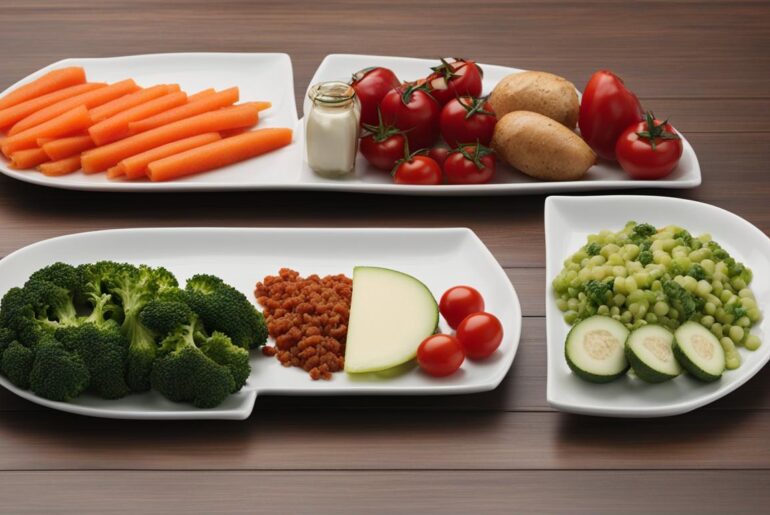Are you still hungry after practicing portion control? It can be frustrating when your efforts to control your food intake don’t leave you feeling satisfied. But don’t worry, there are strategies you can implement to help combat hunger while practicing portion control.
In this article, I will delve into the possible reasons why you might still feel hungry after portion control and provide practical tips and strategies to help you feel full and satisfied. Whether you’re struggling with portion control, or simply want to stay satisfied with the right amount of food, this article has got you covered.
Let’s find out how you can beat hunger on portion control and make your meals more fulfilling.
Key Takeaways
- Understanding your calorie needs and portion sizes can prevent overeating and keep you feeling satisfied.
- Incorporating a small snack before your main meal can help curb your appetite and prevent overeating.
- Mindful eating and slowing down can help you recognize feelings of fullness and prevent overeating.
- Staying hydrated and incorporating high-fiber foods into your diet can contribute to feelings of satiety.
- Experiment with different strategies until you find what works best for you.
The Role of Snacks and Pre-meal Eating in Hunger Management
One strategy to combat hunger on portion control is to have a small snack before your main meal. Opt for low-calorie snacks that are rich in protein and low in sugar, such as a small handful of nuts, a low-fat yogurt, or some olives. These snacks can help take the edge off your appetite and prevent overeating during your main meal. Additionally, having a pre-meal snack can help sustain your energy levels and keep you satisfied until your next meal.
Choosing the Right Snacks
When selecting a pre-meal snack, it’s essential to choose options that are both nutritious and satiating. Here are some nutritious snack ideas to consider:
- A small handful of almonds or walnuts
- A low-fat Greek yogurt
- A hard-boiled egg
- Carrot sticks with hummus
- Sliced turkey or chicken breast
These snacks provide a good balance of protein, healthy fats, and fiber, which can help keep you full and satisfied until your main meal.
The Benefits of Pre-meal Snacks
“Having a small snack before a meal can help curb your appetite and prevent overeating. It gives your body a chance to adjust to the upcoming meal and helps you make better food choices.”
– Registered Dietitian, Jane Smith
Having a small snack before your main meal offers several benefits:
- Appetite Control: Consuming a snack reduces hunger pangs and allows you to better control your appetite during your main meal.
- Blood Sugar Regulation: A balanced pre-meal snack can help stabilize blood sugar levels, preventing energy spikes and crashes.
- Portion Control: By taking the edge off your hunger before your main meal, you’re less likely to overeat and can better adhere to portion control guidelines.
- Sustainability: A pre-meal snack helps sustain your energy levels, preventing extreme hunger and cravings throughout the day.
By incorporating a small snack before your main meal, you can effectively manage your hunger and stay on track with your portion control goals.
| Snack Options | Calories per Serving | Protein per Serving |
|---|---|---|
| A small handful of almonds | 160 | 6 grams |
| Low-fat Greek yogurt | 100 | 15 grams |
| A hard-boiled egg | 78 | 6 grams |
| Carrot sticks with hummus | 120 | 2 grams |
| Sliced turkey or chicken breast | 50 | 10 grams |
Calorie and protein content per serving for common pre-meal snack options.
Understanding Your Calorie Needs and Portion Sizes

When it comes to successful weight management, it’s crucial to recognize that calorie needs and portion sizes are not one-size-fits-all (check this post out). Each individual’s calorie needs are influenced by various factors such as age, gender, height, weight, and activity level.
By understanding your unique calorie needs, you can make informed decisions about portion control and prevent overeating. Personalized portion control is key to ensuring you consume the right amount of calories for your body and goals.
Calculating your individual calorie intake can be done using online tools or by consulting with a professional, such as a registered dietitian or nutritionist. These experts can provide personalized guidance on the optimal calorie intake for your weight loss journey (see my post here). With this knowledge, you can confidently plan your meals and select appropriate portion sizes.
Meal planning for weight loss becomes more effective when you tailor it to your individual calorie needs. By keeping your calorie intake in mind, you can create balanced meals that provide the necessary nutrients without exceeding your energy requirements. This approach helps you achieve a calorie deficit, which is essential for weight loss.
To visually illustrate the importance of understanding calorie needs and portion sizes, consider the following table:
| Example | Calorie Needs | Portion Size |
|---|---|---|
| Individual A | 2000 calories per day | 1 cup cooked rice |
| Individual B | 1500 calories per day | 1/2 cup cooked rice |
This table demonstrates how different calorie needs can correspond to varying portion sizes. Individual A, who requires 2000 calories per day, can consume a larger portion of cooked rice compared to individual B, who needs only 1500 calories per day. By customizing your portion sizes according to your calorie needs, you can maintain a healthy calorie balance.
Understanding your calorie needs and portion sizes empowers you to effectively manage your weight. By making mindful choices, you can align your nutritional intake with your body’s requirements and achieve your weight loss goals.
Making Use of Leftovers and Controlling Portion Sizes
Leftovers can be a source of temptation and can lead to overeating if not managed properly. To avoid wasting food and maintain portion control, follow these practical tips:
- Saving leftovers: Store your leftovers in airtight containers to maintain freshness. This will help preserve the flavors and textures of the food, making it more appetizing when you reheat it later.
- Portion control with leftovers: When reheating leftovers, be mindful of your portion sizes. Use a measuring cup or a food scale to ensure you’re not exceeding your intended portion.
- Reducing food waste: Plan your meals and portion sizes in advance to minimize food waste. Consider repurposing leftovers into new dishes or incorporating them into your meal plan for the week.
- Meal planning for portion control: Include leftovers in your meal planning strategy. For example, if you’re preparing a large batch of chili, portion out the leftovers into individual servings and freeze them for future meals.
By utilizing leftovers effectively and controlling portion sizes, you can not only reduce food waste but also avoid the temptation to overeat. This approach promotes sustainable eating habits and helps you maintain portion control in a practical and convenient way.
Putting Leftovers to Good Use
Leftovers are versatile and can be transformed into delicious new meals. Here are a few ideas to inspire you:
“Transform yesterday’s grilled chicken into a flavorful stir-fry by adding fresh vegetables and a homemade sauce.”
– Chef Emily Thompson
Get creative with your leftovers and experiment with different combinations to create exciting and satisfying dishes.
The Importance of Mindful Eating and Slowing Down

Mindful eating is a practice that focuses on being fully present and aware of the food we consume. It involves eating with awareness and savoring each bite, allowing us to reduce overeating and develop a healthier relationship with food.
When we eat mindfully, we create a calm environment free from distractions such as television or electronic devices. By eliminating these distractions, we can focus on the taste, texture, and satisfaction derived from our meals.
One of the key aspects of mindful eating is slowing down the eating process. By taking the time to thoroughly chew our food, we allow our bodies to register feelings of fullness and satisfaction. This helps prevent overeating and promotes better digestion.
Practicing mindful eating also involves listening to our body’s signals of hunger and fullness. By paying attention to these signals, we can better understand our body’s needs and avoid mindlessly consuming excess food.
In the words of Buddhist monk Thich Nhat Hanh, “When you eat, be completely present. Savor the presence of the food and the presence of your friends and relatives around the table. This is a miracle. We often eat, but we don’t really eat.”
Hydration and Fiber for Satiety
Staying hydrated is essential for overall health and can play a crucial role in managing hunger. One simple yet effective strategy is to drink a large glass of water before each meal. This can create a feeling of fullness, reduce the chances of overeating, and support your weight management goals.
Additionally, incorporating high-fiber foods into your diet can promote satiety and help prevent excessive hunger. Foods such as fruits, vegetables, whole grains, and legumes are excellent sources of dietary fiber. Including these foods in your meals can increase the bulk of your meals without adding excessive calories. Fiber-rich foods take longer to digest, keeping you feeling satisfied for longer periods.
| Fiber-Rich Foods | Fiber Content (per 100g) |
|---|---|
| Apples | 2.4g |
| Broccoli | 2.6g |
| Quinoa | 2.8g |
| Black Beans | 7.5g |
| Chia Seeds | 37.6g |
By combining proper hydration and a fiber-rich diet, you can support your hunger control efforts and maintain satisfaction on your portion-controlled meals.
Conclusion
Implementing effective hunger management strategies is crucial for feeling satisfied with portion control and achieving your weight loss goals. By incorporating practical tips and making small changes to your eating habits, you can overcome hunger on portion control and stay full throughout the day.
One key strategy is to incorporate pre-meal snacks that are low in calories but high in protein. Snacking on options like a small handful of nuts, a low-fat yogurt, or some olives can help curb your appetite and prevent overeating during your main meals.
Additionally, understanding your individual calorie needs and controlling portion sizes are essential for successful portion control. By calculating your calorie requirements and planning meals accordingly, you can avoid overeating and maintain a healthy balance. Practicing mindful eating, slowing down, and savoring each bite can also help you recognize feelings of fullness and prevent overconsumption.
Furthermore, staying hydrated and consuming high-fiber foods can aid in hunger management. Drinking water before meals can create a sense of fullness, while incorporating fruits, vegetables, whole grains, and legumes in your diet can promote satiety and keep you feeling satisfied.
Remember, finding the right combination of strategies is a personal journey. Stay committed, listen to your body’s signals, and experiment with different techniques until you discover what works best for you. With practical tips and a mindful approach, you can overcome hunger on portion control and achieve long-lasting success in managing your weight.




